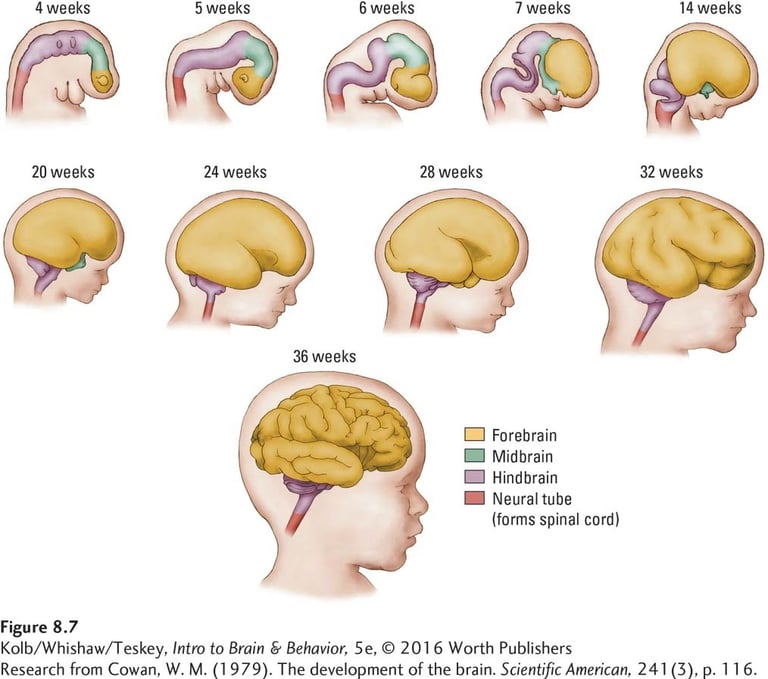
How the Brain Develops
2.2.2. Now that we understand a bit about the smallest part of the brain, the neuron, we look into an overview of how the brain develops and the neuron's role in all of this
ISSUE 2
VJ Tlakula
6/9/20257 min read


How Development Happens - An Overview
Every single day and moment of a child's life matters from the moment they are conceived. Right from conception, complex functions are kicked off and their body is working incredibly hard and at an extremely rapid rate to form the individual that is born after about 9 months. I'd like us to explore a bit about that from the brain level.
Prenatal Brain Development (Before Birth)
When a baby is conceived, what will become their brain begins to develop almost immediately. The brain starts off as a collection of cells. As these cells divide, they create something called a neural tube (which is a hollow, cylinder-shaped group of cells). This neural tube is where the neurons and other cells begin to grow. As this grows, from around 5 weeks, the outer part of it reveals the most basic form of a hindbrain, midbrain, forebrain.
Development of Neurons
There are multiple levels of neural development with slightly complex names. Basically, neurons are born (hundreds of thousands every minute), then they spread out to different areas. As they spread to the different areas there are moments where there is spontaneous electrical activity in the brain which may cause the neurons to fire in certain ways. In this way, they begin to develop "relationships" with their neighbouring neurons where they all fire together and become specialised at a specific task. The more this happens, the stronger these bonds become and the better the brain becomes at performing the specific task, until it becomes natural to perform. As the brain specialises and adapts to the environment in later stages, some bonds are no longer necessary for efficiency. These get "pruned" until the specific area of the brain is performing at its optimal performance.
These bonds of communication are known as synapses, and it is within these synapses (which are actually a gap between neurons) that electrochemical signals, called neurotransmitters, are sent and communication and action happens.
The specialisation of a group of neurons can also depend on where they are in the brain and what kind of information they will be receiving. For example, neurons which settle in the visual area are close to the area that receives information from the eyes, therefore, they will be focused on processing vision. Neurons which are close to the mechanisms of the nose or ears, will become specialised to process smells or sounds, respectively. Different neurons are also affected by the various molecular signals happening in the areas where they are. Different brain areas respond to different stimuli in different ways and the environment of response around the neuron can also determine how it is specialised.
How the Brain Physically Grows
So, we know that the brain grows as it learns and new neurons are born, but how exactly does this happen? The brain itself quite literally grows in two main ways: older neurons are simply pushed further away from the centre (in a passive way) and they end up forming certain areas of the brain. The other way is that as neurons are born, they are guided along certain paths to certain areas of specialisation.
As more and more neurons are born, they become brain tissue. There's another type of tissue called a glial cell which also grows at this point (but we're not discussing that right now). Because the human brain needs to perform so many tasks and the brain is growing at an extremely rapid rate in quite a small space, during this time, it begins to have that folded shape that we are so familiar with when see pictures of the brain. This shape is to accommodate a huge amount of brain tissue in a small space. Some parts of the brain tissue (or matter) end up more densely packed with neuron somas (called grey matter) which is where information is stored. Others are more packed with the long axons (called white matter tracts) and that makes them more optimised for sending high-speed communication and messages between brain areas. Recap about the structure and function of the neuron here.
Postnatal Brain Development (After Birth)
By 9 months, when the child is born, all the areas of their brain have formed, though obviously not at mature level or functioning. As they develop and are exposed to the environment, their brain learns to make stronger bonds in certain areas and get rid of bonds that are not useful in other areas.
As the child learns, their brain grows and grows until with experience, and their particular context, their brain learns what is relevant and what isn't. Some areas have more connections than are needed and others have less. The postnatal developing brain is constantly working to find this balance, which it stabilises at maturity around 25 years old. This ongoing process is called synaptogenesis and can continue, though at a different rate throughout life. This kind of fine-tuning is what can make certain cultures better at certain tasks compared to others, even though all brains develop the same way (for example, being able to produce certain sounds because your language uses that sound, someone whose language never grew using that sound, will struggle to produce it).
This is another example of the environment playing a massive role in development. Through understanding this, we realise that both the period before birth and after birth are crucial to development, and the environment has a significant role to play. Every single day's experience can cause changes to the literal structure and functioning of the brain. This is another reason I say that no brain or human ever develops in isolation without being affected by their environment.
When we think of cognitive ability and efficient brain functioning from this understanding, we realise that cognitive functioning (how the brain executes tasks) is, in addition to other things like genetics, a consequence of fine-tuning of synapses and the brain's responses to environmental experiences.
Tasks
When I speak of different "tasks being performed by neurons, I mean every possible thing that the brain does which you could think of. When the developing brain is learning, growing, and performing tasks, it is an interplay between the way the brain is designed to work and the environmental input. For example, when a young baby is learning to grasp (grab things and hold on), there are many elements involved. Among the many different tasks happening at the neuronal level, there are neurons involved in seeing the object, calculating how far they are from the object and instructing the body and arm towards the object, instructing the fingers to move in a certain way that they can grab and hold on. Different brain structures and hemispheres are all working together to execute this one major task. They are all executing smaller tasks at their level and the neuron level to accomplish this.
Initially, when this is an extremely new experience, the baby will struggle to co-ordinate or sustain the will for that action. This is where you see them struggling and failing in different ways. But the more they try, the more the neurons fire and learn what works best, what the mistakes are, and how to correct them. Neurons involved in vision, planning and motor co-ordination are working and being refined in this process. You will see that with all that effort, they get better at doing it until they can firmly execute the action without difficulty. When they need to do it again, the brain will remember the process it took to fulfil and accomplish it quicker. The more this happens, the more firm those communication signals and tracks will become in the brain, until the action becomes natural. The same idea can be said about learning to walk, speak, recognise faces, etc.
Brain Plasticity
When we discuss the developing brain, we also need to touch on the idea of brain plasticity. Plasticity is the brain’s ability to flexibly recover and re-organise itself after something has affected it in the environment. It is a biological response to an environmental change. How "plastic" the brain is, is how easily it is able to do this.
Remember how the brain is organised into different sections? Sometimes things happen which mean that one part of the brain will no longer work or work well, or needs to be removed. Plasticity means that the brain is able to assign the tasks which were performed in that part of the brain to another section that might not normally carry that load as much. It is able to do this without too much negative effect when the individual is vey young.
The brain is most plastic when it’s young. The older you get, the less plastic your brain is. This means that it is harder for your brain to recover from damage when you are older, whereas if damage happens to young children, the effects are much less noticeable and they perform at almost the same level as their peers. This is one biological explanation for idioms like “you can’t teach an old dog new tricks” or “it’s difficult to bend a branch that has already grown”.
Once a brain is set in its ways and those neural pathways have been solidly created, it becomes extremely difficult to change. This is another reason why we say that children are mouldable and impressionable - their brains are still learning and are not set in their ways. This peak period for recovery and influence is known as a sensitive period and occurs within the first 1001 days of a child's life (discussed more in Part 3), from the moment they are conceived. This is also why even though the adult brain is capable of producing new neurons, it's not at the same rate, ease or efficiency as the developing brain.
The Takeaway
This piece demonstrates how brain functioning boils down to its most critical cell - the neuron. Even at this most basic biological level (as we will see with the gene), the environment is playing a part. The development of the brain shows that it is constantly learning and growing right from day 1 in the mother's stomach, because this is how it literally grows. Because of this process, the young child’s brain works fundamentally differently to the adult brain. Our next Part shows how important the environment is in this growth.


Share your Comments Below!
Please feel free to reach out with any comments, questions, and child-related stories
Celebrating childhood and development
© Ntsako Wholeness and Joy in Childhood 2025. All rights reserved.
Copyright Vutlhari Joy Tlakula 2025. All Rights Reserved.


